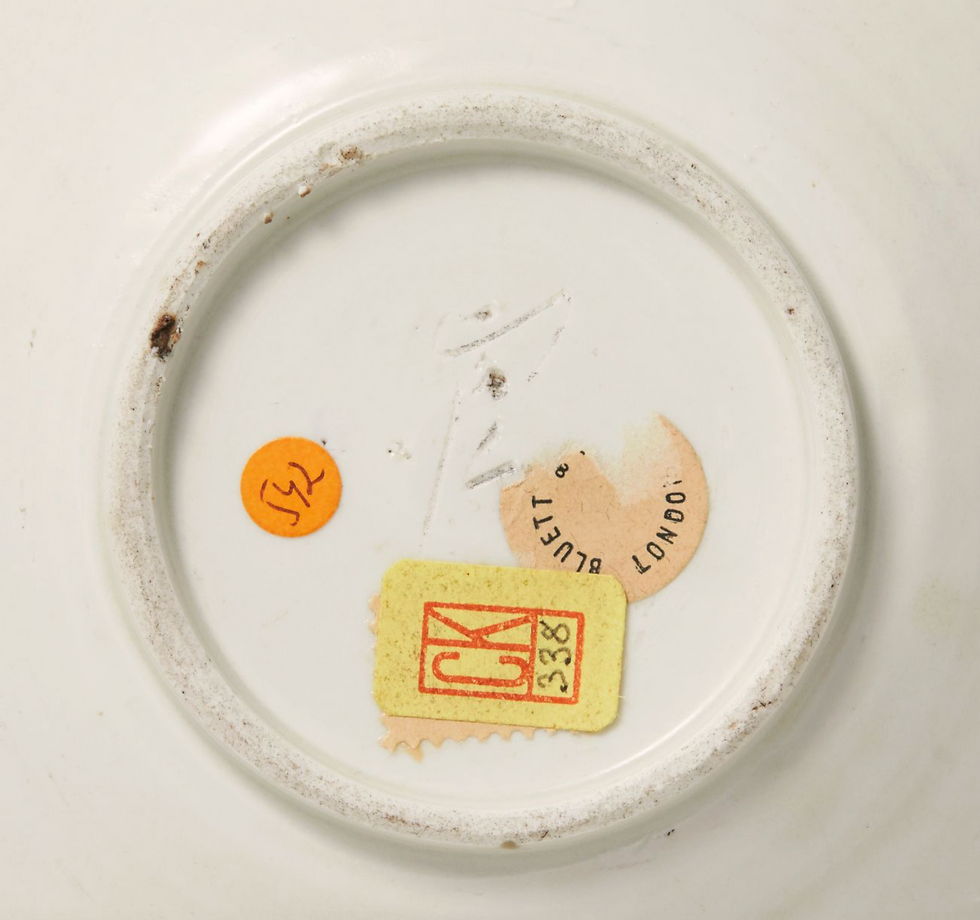拍賣筆記 vol.249 繭山龍泉堂:晚唐定窯「官」款白釉輪花盤(花口盤) - Mayuyama, A White Porcelain Foliate-Rim Dish With 'Guan(官)' Inscription, Late Tang Dynasty
- SACA

- Oct 24
- 5 min read

邦瀚斯香港拍賣有一例同款作品,參考:《拍賣筆記 vol.248 邦瀚斯香港:五代至北宋定窯「官」款白釉花口盤 - Bonhams HK, A Rare Large Ding White-Glazed 'Guan'-Inscribed Foliate-Rim Dish, Five Dynasties - Northern Song Dynasty》
A comparable example was offered at Bonhams Hong Kong; see Auction Notes vol.248: Bonhams Hong Kong – A Rare Large Ding White-Glazed ‘Guan’-Inscribed Foliate-Rim Dish, Five Dynasties to Northern Song Dynasty.

白磁輪花盤 「官」字銘
WHITE PORCELAIN FOLIATE-RIM DISH WITH 'GUAN(官)' INSCRIPTION
定窯 晩唐(9〜10世紀)
高 3.3 cm 径 13.4 cm
来歴
Bluett & Sons, ロンドン.Carl Kempe(1884〜1967年)旧蔵.
所載
Gustaf Lindberg「Hsing-Yao and Ting-Yao」『The Bulletin of the Museum of Far Eastern Antiquities』no. 25, The Museum of Far Eastern Antiquities, 1953年, 図版49, 図44.Bo Gyllensvärd『Chinese Ceramics in the Carl Kempe Collection』Almquist & Wiksell, 1964年, 図版338.Thomas Dexel『Frühe Keramik in China』Klinkhardt & Biermann, 1973年, 図版58c.Margaret Medley『T'ang Pottery and Porcelain』Faber and Faber,1981年, 図版115.

這是一件造形極為洗練的定窯白瓷輪花盤。其胎體雖薄,卻以極為精煉的瓷土燒結而成,胎質緊密堅實,毫無脆弱之感,呈現出晚唐定窯成熟自信的技藝水準。釉面潤澤瑩亮、質地優美,整體施釉勻淨,充分展現出定窯於形制與白度兩方面所達到的高度完成度。由此可見,作為宋代名窯的定窯,其優異的技術與審美,在晚唐時期已臻成熟。
此盤底部刻有「官」字銘,顯示其可能為宮廷進貢或特別製作的御用品。帶有銘文的定窯作品極為罕見,目前所知僅有極少數可資對比的例證。例如在中國江南地區建立吳越國的開國君主錢鏐(852–932)之父錢寬與母水丘氏的墓葬中,皆出土過刻「官」字的白瓷器。錢寬葬於公元900年,水丘氏葬於901年,是目前可確定年代的最早一批帶「官」銘白瓷。這些考古材料表明,在唐末時期,已經有專為王侯階層燒造的最高等級白瓷器物,且其銘文「官」不僅代表品質與地位,更反映了當時白瓷作為禮制器、御用器的象徵性功能。
至五代至北宋初期,帶「官」銘的白瓷仍持續燒造,但工藝上逐漸呈現出更細薄、輕巧的特徵——胎體更薄,高台更小,整體造形更加纖麗婉約。相較之下,卡爾・坎普(Carl Kempe)舊藏的這件輪花盤,雖在形制上與五代作品相似,但其高台較為寬闊穩重,輪花線條飽滿有力,仍保留著唐代的典雅雄渾之氣,可視為承先啟後、銜接唐與宋之間的典型代表。它不僅體現了晚唐白瓷技藝的巔峰,也象徵著唐宋交替之際審美轉化的關鍵時刻。
藏家卡爾・坎普(1884–1967)為瑞典最具代表性的中國陶瓷收藏家之一,尤以精選白瓷與青瓷而聞名。他的收藏以兼具美學高度與學術價值著稱,常被用以研究中國陶瓷的技術與風格演變。這件刻「官」銘的定窯白瓷輪花盤,正體現出坎普收藏的典型特徵——既具卓越的藝術品質,又蘊含深厚的歷史意義。由於其稀有的銘文與精湛的工藝,此盤多次被收錄於重要出版物中,被視為中國陶瓷史上極具指標性與研究價值的名品。

A White Porcelain Foliate-Rim Dish With 'Guan(官)' Inscription
Late Tang (9th–10th centuries)
H. 3.3 cm Dia. 13.4 cm
PROVENANCE
Bluett & Sons, London.Carl Kempe (1884-1967) Collection.
LITERATURE
Gustaf Lindberg, “Hsing-Yao and Ting-Yao”, The Bulletin of the Museum of Far Eastern Antiquities, no. 25, The Museum of Far Eastern Antiquities, 1953, pl. 49, fig. 44.Bo Gyllensvärd, Chinese Ceramics in the Carl Kempe Collection, Almquist & Wiksell, 1964, pl. 338.Thomas Dexel, Frühe Keramik in China [Early Ceramic in China], Klinkhardt & Biermann, 1973, pl. 58c.Margaret Medley, T'ang Pottery and Porcelain, Faber and Faber, 1981, pl. 115.
This finely shaped Ding ware lobed dish represents the pinnacle of refinement achieved by the kilns of northern China during the late Tang period. Although delicately potted, the body is composed of a highly purified, densely fired porcelain clay, resulting in remarkable strength and precision. The glaze, of exceptional clarity and lustre, attests to the technical and aesthetic maturity already attained by the Ding kilns at this time.
An incised character guan (“official”) is found on the base, suggesting that the dish was made as a court commission or tribute piece of the highest quality. Such inscribed examples are exceedingly rare. Comparable pieces have been unearthed from the tombs of Qian Kuan (d. 900) and his wife, Lady Shuiqiu (d. 901), the parents of Qian Liu (852–932), founder of the Wuyue kingdom. These dated finds confirm that white porcelains inscribed with the guan mark were already produced in the late Tang dynasty for the highest aristocratic ranks, serving as symbols of imperial taste and authority.
While white wares bearing guan inscriptions continued to be made into the Five Dynasties and early Northern Song periods—with thinner walls, narrower footrings, and a more delicate profile—the present dish from the Carl Kempe Collection preserves broader, more stable proportions and a powerful lobed contour, qualities reminiscent of Tang prototypes. It thus stands as a transitional masterpiece embodying the evolution from Tang to Song aesthetics.
Carl Kempe (1884–1967), one of Sweden’s foremost collectors of Chinese ceramics, was renowned for his discerning assemblage of white and celadon wares of exceptional beauty and scholarly importance. This lobed dish, bearing the rare guan inscription, exemplifies the refined yet authoritative character of the Kempe Collection and has been repeatedly published as a seminal example of late Tang Ding ware in the history of Chinese ceramics.

洗練された造形をした輪花の盤です。磁胎は薄く作られていますが、その胎土はよく精錬され焼き締まっており、弱い印象は全くありません。釉薬も大変上質です。宋代の名窯として名高い「定窯」は、晩唐期には既に優れた形と白さにおいて早くも完成期を迎えていたことが、本作のような優品から看取されるでしょう。
本作の底部を見ると「官」の銘が刻されており、定窯作品の中でも特別な宮中献上用の精品であった可能性が示唆されます。こうした有銘の例は極めて希少で、江南地方で勢力を築いた呉越国の初代国王銭鏐の父銭寛せんかん、母水丘すいきゅう氏の墳墓埋葬品などの例が知られるのみです。銭寛は900年、水丘氏は901年に埋葬されており、晩唐期には「官」字銘が刻された最高級の白磁が作られた年代の分かる早い例として知られています。またこれら在銘白磁が、国王クラスの上流階級のために作られた最上級の白磁であったことが判明する点も大変重要です。「官」銘を有する白磁は、のちの五代〜宋初まで作られ続けますが、胎がより薄く、高台径も小さくなるなど、全体的に繊細な作りとなっていきます。このケンペコレクションの白磁輪花盤は一見五代の典型のようにも見えますが、五代や宋初の作例と比較すると高台が広く安定感があり、輪花の造形も力強い点などにややクラシカルな唐代の要素が感じられます。本作は宋磁へと繋がっていく晩唐という時代を象徴するような一品と云えるでしょう。
旧蔵者Carl Kempe(1884〜1967年)はスウェーデンを代表する中国陶磁蒐集家で、特に優れた白磁と青磁のコレクションで知られています。彼の蔵品は美的なレベルの高さと、学究的な要素を兼備した作例が多い傾向があり、「官」字銘を有するこの輪花盤は、まさにケンぺコレクションといった趣をもっています。この輪花盤は貴重な在銘定窯白磁として度々書籍でも言及されるなど、中国陶磁史の中でも重要な品として知られています。

























Comments